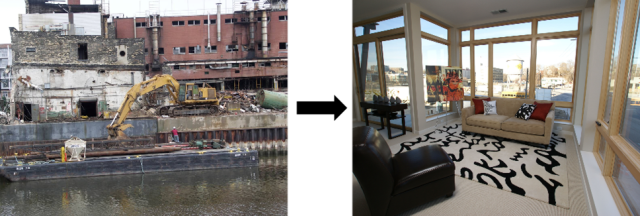EPA Researchers Explore Brownfield Revitalization’s Effects on Communities
Published October 1, 2024
Brownfields are underused properties where expansion, reuse, or redevelopment is complicated due to the presence or potential presence of a hazardous substance, pollutant, or contaminant. Examples include areas that were formerly gas stations, warehouses or factories, industrial facilities, and more. Brownfield sites are often located in areas that have a higher percentage of minority populations, as well as populations that are low income, linguistically isolated, or less likely to have a high school education than the broader U.S. population. Brownfields can also result from poor or unfair past land management practices or socioeconomic policies.

Cleaning up brownfield sites offers several benefits to the community, including improvements in the environment and facilitation of job growth. Redeveloping brownfield sites can also lead to fewer empty and paved surfaces, leaving more room for parks and other greenspaces that the surrounding community can enjoy, in turn leading to property value increases. While these are many positive benefits, there are also concerns that some residents may be impacted in unforeseen ways. It is critical to ensure that researchers examine the impact of revitalization on communities so that all residents living in brownfield communities reap the benefits of redevelopment.
To look at these questions, a research team came together to investigate possible intersections between brownfield redevelopment and gentrification. The team included EPA researchers and regional staff (Dr. Brittany Kiessling, Dr. Emily Eisenhauer, Dr. Keely Maxwell, Dr. Kathleen Williams, Dr. Jonathan Essoka, Brittany Clark, Ashley Green, John Jurevis, Stephanie Ross, Torre Ippolito, Jackie Coreno), as well as contractors for Eastern Research Group (Shanika Amarakoon, Sinead Keogh, and Elizabeth Lanphear).

EPA researchers collected and analyzed neighborhood-level data in four neighborhood areas with brownfields in Indianapolis, Milwaukee and Philadelphia. The team worked in these communities to explore the impacts that brownfields cleanup and reuse has on communities, focusing particularly on social impacts. From this data, the team will be able to describe the approaches to brownfield redevelopment that have been successful in bringing benefits to the community. They plan to develop measures which can be used to design and track outcomes of future brownfield redevelopment projects.
As the project comes to an end this month, the team will share the results with state and local agencies as well as community members. This work has improved collaboration between EPA staff and local communities. To learn more about the results of this project, you can view a recording of the Healthy and Resilient Communities Webinar that took place on September 10.
